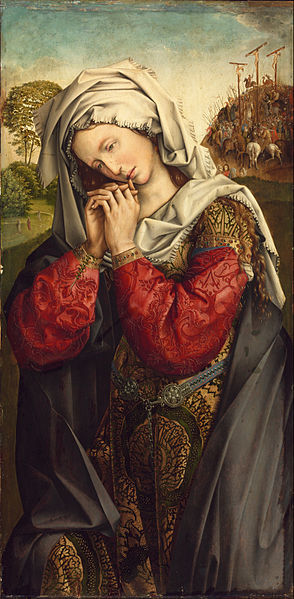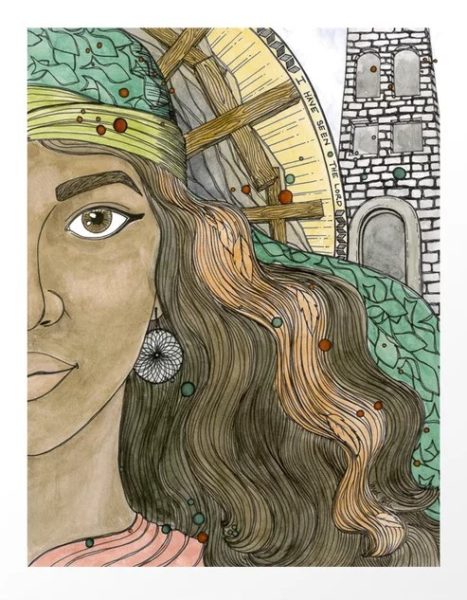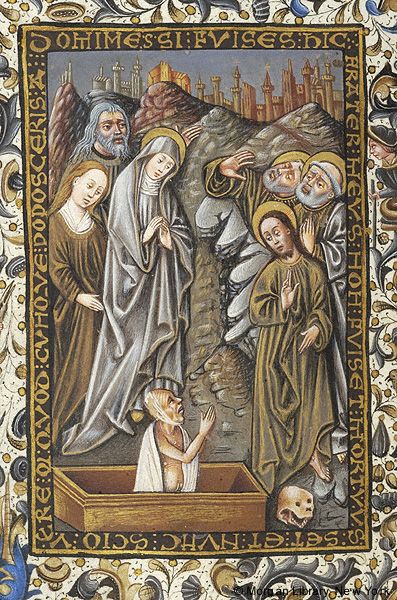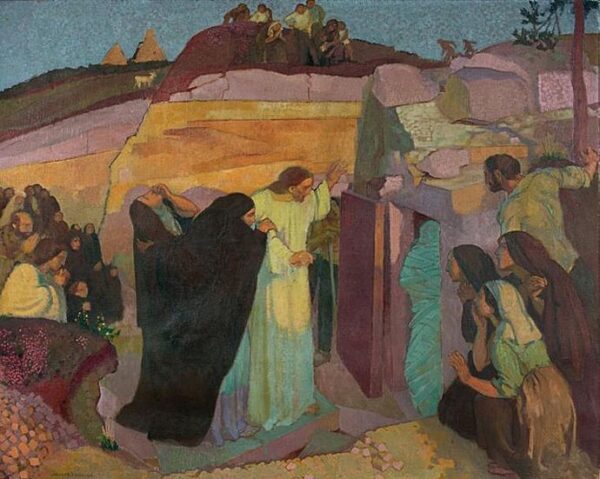 I was alerted to the recent buzz about Mary Magdalene by my friend Laurie, who sent me this link to a sermon preached by Dr. Diana Butler Bass on the closing day of the Wild Goose Festival, July 17, 2022. In this sermon, Diana mentions research started in 2017 by Elizabeth (Libbie) Schrader, a PhD student at Duke University. Libbie, based on her examination of various early manuscripts, hypothesizes that the name Martha was added to the original story of the raising of Lazarus in John chapters 11 and 12. If this is correct, she is positing that Mary Magdalene was the sister of Lazarus from Bethany, and that the sisters Martha and Mary in Luke 10:32-48 are separate and unrelated to Lazarus. The Mary and Martha story in Luke does not identify the location of their house, but based on the travels of Jesus at that time, Bethany does not make sense.
I was alerted to the recent buzz about Mary Magdalene by my friend Laurie, who sent me this link to a sermon preached by Dr. Diana Butler Bass on the closing day of the Wild Goose Festival, July 17, 2022. In this sermon, Diana mentions research started in 2017 by Elizabeth (Libbie) Schrader, a PhD student at Duke University. Libbie, based on her examination of various early manuscripts, hypothesizes that the name Martha was added to the original story of the raising of Lazarus in John chapters 11 and 12. If this is correct, she is positing that Mary Magdalene was the sister of Lazarus from Bethany, and that the sisters Martha and Mary in Luke 10:32-48 are separate and unrelated to Lazarus. The Mary and Martha story in Luke does not identify the location of their house, but based on the travels of Jesus at that time, Bethany does not make sense.
As you know, I have an affinity for Mary Magdalene and celebrated her feast day with my friends in Houston every year for over a decade. You can find my blog post about the visual art iconography of the Assumption of a hairy Mary Magdalene here and a review of some of the books that have been written about Mary Magdalene and that I have read here. So as new books continue to be published and noncanonical texts analyzed, why should I be surprised that more research and information about MM keeps coming up? I guess I would just say that I had thought maybe this big threshold change in my life was calling me to let go of Mary Magdalene to make room for something new. However, maybe MM isn’t finished with me yet…… In my mind, this research is just explosive!
So the story is that Libbie was working on her master’s thesis at General Theological Seminary in New York City, and her advisor recommended that she focus her interest in Mary Magdalene on the Gospel of John. To begin to do this, she examined the newly-digitized copy of Papyrus 66, which is the oldest (circa 200 ce,) most complete extant copy of John’s gospel. The miracles of the internet abound, and you can look at Papyrus 66 yourself here.
Libbie found that the first sentence of the Greek text of John 11:1 read, “Now a certain man was ill, Lazarus of Bethany, the village of Mary and his sister Mary.” Of course this is really confusing, mostly because Mary was such a common name for Jewish women in the New Testament and there are two Marys referenced in the sentence. Libbie noticed that in the story of the raising of Lazarus in John chapters 11 and 12, the second name Mary had been changed to Martha by writing the letter theta over the letter iota and the pronoun was changed from his to her. These edits effectively change the first sentence into what we are familiar with, “Now a certain man was ill, Lazarus of Bethany, the village of Mary and her sister Martha.”
 In a 2021 lecture, sponsored by FutureChurch, Libbie listed other documents she examined that omitted Martha, including the first printing of the King James Bible in 1611, the 1526 Tinsdale Bible, the 1591 Bishop’s Bible and documents written by early church leaders, such as Tertullian and Origen. It seems clear that there is some inconsistency and uncertainty surrounding the identity of the sister(s) of Lazarus in multiple texts.
In a 2021 lecture, sponsored by FutureChurch, Libbie listed other documents she examined that omitted Martha, including the first printing of the King James Bible in 1611, the 1526 Tinsdale Bible, the 1591 Bishop’s Bible and documents written by early church leaders, such as Tertullian and Origen. It seems clear that there is some inconsistency and uncertainty surrounding the identity of the sister(s) of Lazarus in multiple texts.
So what does all of this mean? It’s not unusual for scribes to make corrections, and, in the case of Papyrus 66, around 450 changes or corrections were made to the gospel manuscript. As with anything interesting and important, the textual anaylsis appears to present a difficult, potentially confusing, and technical challenge. But what makes it explosive to me is perhaps the ultimate question: If Mary Magdalene is the sister of Lazarus, and Martha was not originally present, why would the wording have been changed to add Martha? Did an inexperienced scribe, knowing the story from Luke, just try to resolve a badly written sentence in a way that made more sense? Was it because the scribe was trying to reconcile two texts with conflicting accounts of the story? Was the scribe unusually careless?
A blog post by Marg Mowczko discusses the relevant passages. She writes, “The original scribe of P66 didn’t omit Martha. He made mistakes in John 11:1 and 3 which he corrected, perhaps as he was going along writing out John’s Gospel… So, after a messy start at the beginning of John 11 in P66, Martha is present and correct, and where we expect her name to be, in the remainder of John 11-12. I count eight times that Martha’s name is mentioned in John 11:5–12:2. Martha is not missing from this manuscript.” Marg also mentions that MM is referred to as Magdalene later in the gospel of John, so the absence of this title in the Lazarus story could contradict this theory that Mary Magdalene was Lazarus’ sister and that Martha was added later.
So there is another possibility for the confusion about Mary and Martha. Could the inconsistencies and multiple corrections indicate some kind of inadvertant prejudice or intentional subterfuge to sabatoge Mary Magdalene’s reputation as the Apostle to the Apostles? Here is the account of Martha (or hypothetically Mary Magdalene) who ran out to greet Jesus, according to my copy of the Bible:
 When Martha heard that Jesus was coming, she went to meet him, while Mary stayed at home with the mourners. When she got to Jesus, Martha said, “If you had been here, my brother would never have died! Yet even now, I am sure that God will give you whatever you ask.” “Your brother will rise again!” Jesus assured her. Martha replied, “I know he will rise again in the resurrection on the last day.” Jesus told her, “I am the Resurrection and I am Life: those who believe in me will live, even if they die; and those who are alive and believe in me will never die. Do you believe this?” “Yes!” Martha replied. ” I have come to believe that you are the Messiah, God’s Only Begotten, the One who is coming into the world.”
When Martha heard that Jesus was coming, she went to meet him, while Mary stayed at home with the mourners. When she got to Jesus, Martha said, “If you had been here, my brother would never have died! Yet even now, I am sure that God will give you whatever you ask.” “Your brother will rise again!” Jesus assured her. Martha replied, “I know he will rise again in the resurrection on the last day.” Jesus told her, “I am the Resurrection and I am Life: those who believe in me will live, even if they die; and those who are alive and believe in me will never die. Do you believe this?” “Yes!” Martha replied. ” I have come to believe that you are the Messiah, God’s Only Begotten, the One who is coming into the world.”
(John 11:20-27)
Jesus’ statement, “I AM the Resurrection and I AM Life,” is one of the most important I AM statements in the Gospel of John. I kind of liked that busy Martha, who was chastised by Jesus in Luke 10:32-48, was the one who finally “got it” and who proclaimed, “I have come to believe that you are the Messiah.” However, the idea that it is MM who greeted Jesus passes a common sense check for me, especially in light of the fact that there were many different Christian communities during the first century and a large variety of texts, including noncanonical manuscripts, that were circulating at the time. This statement by Martha/MM is one of only two Christological confessions noted in the gospels, and the other one was proclaimed by Peter, as-described below.
When Jesus came to the neighborhood of Caeserea Philippi, he asked the disciples this question, “What do people say about who the Chosen One is?” They replied, “Some say John the Baptizer, others say Elijah, still others Jeremiah or one of the prophets.” “And you,” he said, “Who do you say that I am?” “You are the Messiah,” Simon Peter answered, “the Firstborn of the Living God!” Jesus replied, “Blessed are you, Simon begot of Jonah! No mere mortal has revealed this to you, but my Abba in heaven. I also tell you this: your name now is ‘Rock’ and on bedrock like this I will build my community, and the jaws of death will not prevail against it.” (Matthew 16:13-18)
The words magdala in Aramaic and migdal in Hebrew mean tower, so it is entirely possible that Tower was a title or nickname for Mary Magdalene. She surely towered above many in her love and dedication to Jesus and in her response to his post-resurrection commission of her as the Apostle to the Apostles. It makes some kind of parallel sense to me that Peter makes the Christological confession and is named Peter the Rock, and Mary makes the Christological confession and is named Mary the Tower.
But then does that mean that Mary of Bethany and Mary of Magdala are the same person? Maybe. Maybe not. As it turns out, there is currently a debate about where Mary Magdalene is actually from. Many people assume that Mary must be from a village named Magdala, and there were many villages with similar names in the area at the time. Towers were prevalent in the area at the time, used to protect and administer agricultural and pastoral lands. Perhaps the most obvious possible location is Migdal on the Sea of Galilee, where archaeological excavations of the village and a first century bce synagogue have been conducted.
In a second lecture in 2022, sponsored by FutureChurch, Libbie and Joan Taylor presented additional research related to the idea that Μαγδαληνή (Magdalene) is a nickname rather than a designation of Mary’s village. See also Reference 5. Libbie showed evidence that the author of Luke-Acts frequently used the verb “called” in the descriptions of many different people, such as “a young man called Saul,” “Simeon called the black,” “John called Mark,” and “Simon called Peter.” And in Luke 8:1-3, when we learn that Jesus had cast seven demons out of Mary, she is referred to in the Greek text as Maria hē kaloumenē Magdalēnē (Mary called Magdalene.)
 In addition, Joan discussed several villages with names similar to Migdal or Magdala that she investigated to see whether there is any plausible connection to Mary Magdalene. As I mentioned above, there is a site called Magdala on the Sea of Galilee that is considered by many to be the village that MM was originally from. However, Joan was not convinced and discussed a more relevant site called Migdal Nuniyya (Fish Tower) that is located near Tiberias. In the end, she stated that, in her opinion, there is not currently enough evidence to conclude that any of the Migdal/Magdala sites could be the village that Mary came from.
In addition, Joan discussed several villages with names similar to Migdal or Magdala that she investigated to see whether there is any plausible connection to Mary Magdalene. As I mentioned above, there is a site called Magdala on the Sea of Galilee that is considered by many to be the village that MM was originally from. However, Joan was not convinced and discussed a more relevant site called Migdal Nuniyya (Fish Tower) that is located near Tiberias. In the end, she stated that, in her opinion, there is not currently enough evidence to conclude that any of the Migdal/Magdala sites could be the village that Mary came from.
There is a third possibility related to the name Mary the Magdalene. If Magdala doesn’t refer to her towering faith or the location of her hometown, it’s possible that Magdala could refer to her profession. Marg Mowczko writes that “an almost identical word to magdala can mean ‘hairdresser,’ from gadal which means ‘to weave, to twine, to plait, to dress hair.’ ” She refers to research on A Commentary of the New Testament from the Talmud and Hebraica, written by John Lightfoot in 1658, that equates plaited hair with prostitution. And yet again this brings us back to the unfounded, yet unfortunately familiar description of Mary Magdalene as a reformed prostitue.
It seems clear that there is still more work to be done to answer numerous questions related to Mary Magdalene. I am looking forward to following the research as it continues to unfold.
Readings: The Inclusive New Testament, Priests for Equality, Brentwood, MD, 1994.
Reference 1: Schrader. Elizabeth, “Was Martha of Bethany Added to the Fourth Gospel in the Second Century?” Harvard Theological Review, Volume 110, Issue 3, July 2017, pp. 360-392, https://dukespace.lib.duke.edu/dspace/handle/10161/18592.
Reference 2: Digital copy of Papyrus 66, Gospel of John, https://archive.org/details/papyrus66.
Reference 3: Women Erased: Mary Magdalene and the Gospel of John, FutureChurch video presentation by Elizabeth Schrader, August 26, 2021.
Reference 4: Women Erased: The Magdalene Mystery, FutureChurch video presentation, by Elizabeth Schrader and Joan Taylor, April 28, 2022.
Reference 5: Shimron, Yonat,”Was Mary Magdalene Really from Magdala?” Religion News Service, January 2022.
Reference 6: Mowczko, Marg, “Is Martha Missing in the Oldest Surviving Text of John 11?” blog post, August 2, 2022.
Reference 7: Mowczko, Marg, “Who was Mary the Magdalene?” blog post, May 26, 2014.
Image 1: The Mourning Mary Magdalene, by Colijn de Coter, Museum of Fine Arts Budapest, accession number 5199, circa 1500-1504.
Image 2: Art by Sarah Beth Baca Art, sarahbethart.com, used with permission, 2022.
Image 3: Book of Hours, JP Morgan Library, originally from Spain, perhaps Burgos or Segovia, circa 1465-1480, MS M.854, fol. 154v.
Image 4: The Raising of Lazarus, by Geertgen tot Sint Jans, Musée du Louvre, Paris, France, circa 1480.
Image 5: The Raising of Lazarus, 1919, by Maurice Denis (1870-1943,) Musée départemental Maurice Denis, Saint-Germain-en-Laye, Paris, France.















2 Comments
Leave your reply.